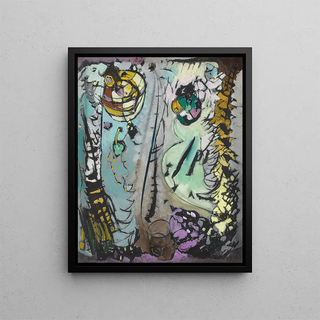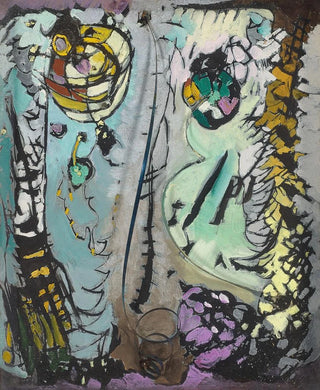Art print | George Gershwin Rhapsody in Blue, Part I - Arthur Dove


View from behind

Frame (optional)
George Gershwin Rhapsody in Blue, Part I - Arthur Dove – Captivating Introduction
The art print of George Gershwin Rhapsody in Blue, Part I - Arthur Dove invites you on a sensory journey into the heart of music and painting. This iconic piece, which harmoniously blends Gershwin's notes with Dove's nuances, evokes a visual melody. As you contemplate this work, you are transported into a universe where rhythm and color intertwine, creating an atmosphere that is both vibrant and soothing. The artist manages to capture the essence of an era, the 1920s, marked by unprecedented cultural effervescence, where jazz music and visual arts intertwine.
Style and uniqueness of the work
Arthur Dove, a pioneer of abstraction, stands out for his innovative and poetic approach. In this piece, he uses organic shapes and warm colors to translate the emotions evoked by Gershwin's music. The flowing lines and dynamic compositions reflect a constant search for harmony between sound and vision. Each brushstroke seems to dance to the rhythm of the melody, creating a synergy between pictorial art and musical art. This unique fusion gives birth to a work that does not merely depict a scene but evokes a state of mind, an ambiance, a sensory experience. The use of color, sometimes vibrant, sometimes subtle, plays a key role in this alchemy, inviting the viewer to feel the music beyond the simple notes.
The artist and his influence
Arthur Dove, a central figure in 20th-century American art, managed to leave his mark on his era with his innovative approach. As a pioneer of abstraction, he paved the way for many artists who followed in his footsteps. His work, often inspired by nature and music, influenced generations of artists, encouraging them to explore new dimensions in their creations. Dove always sought to translate deep emotions through his art, and his collaboration with composers like George Gershwin testifies to his desire to create bridges between different forms of artistic expression. By integrating elements of music into his painting, he

Matte finish

View from behind

Frame (optional)
George Gershwin Rhapsody in Blue, Part I - Arthur Dove – Captivating Introduction
The art print of George Gershwin Rhapsody in Blue, Part I - Arthur Dove invites you on a sensory journey into the heart of music and painting. This iconic piece, which harmoniously blends Gershwin's notes with Dove's nuances, evokes a visual melody. As you contemplate this work, you are transported into a universe where rhythm and color intertwine, creating an atmosphere that is both vibrant and soothing. The artist manages to capture the essence of an era, the 1920s, marked by unprecedented cultural effervescence, where jazz music and visual arts intertwine.
Style and uniqueness of the work
Arthur Dove, a pioneer of abstraction, stands out for his innovative and poetic approach. In this piece, he uses organic shapes and warm colors to translate the emotions evoked by Gershwin's music. The flowing lines and dynamic compositions reflect a constant search for harmony between sound and vision. Each brushstroke seems to dance to the rhythm of the melody, creating a synergy between pictorial art and musical art. This unique fusion gives birth to a work that does not merely depict a scene but evokes a state of mind, an ambiance, a sensory experience. The use of color, sometimes vibrant, sometimes subtle, plays a key role in this alchemy, inviting the viewer to feel the music beyond the simple notes.
The artist and his influence
Arthur Dove, a central figure in 20th-century American art, managed to leave his mark on his era with his innovative approach. As a pioneer of abstraction, he paved the way for many artists who followed in his footsteps. His work, often inspired by nature and music, influenced generations of artists, encouraging them to explore new dimensions in their creations. Dove always sought to translate deep emotions through his art, and his collaboration with composers like George Gershwin testifies to his desire to create bridges between different forms of artistic expression. By integrating elements of music into his painting, he






